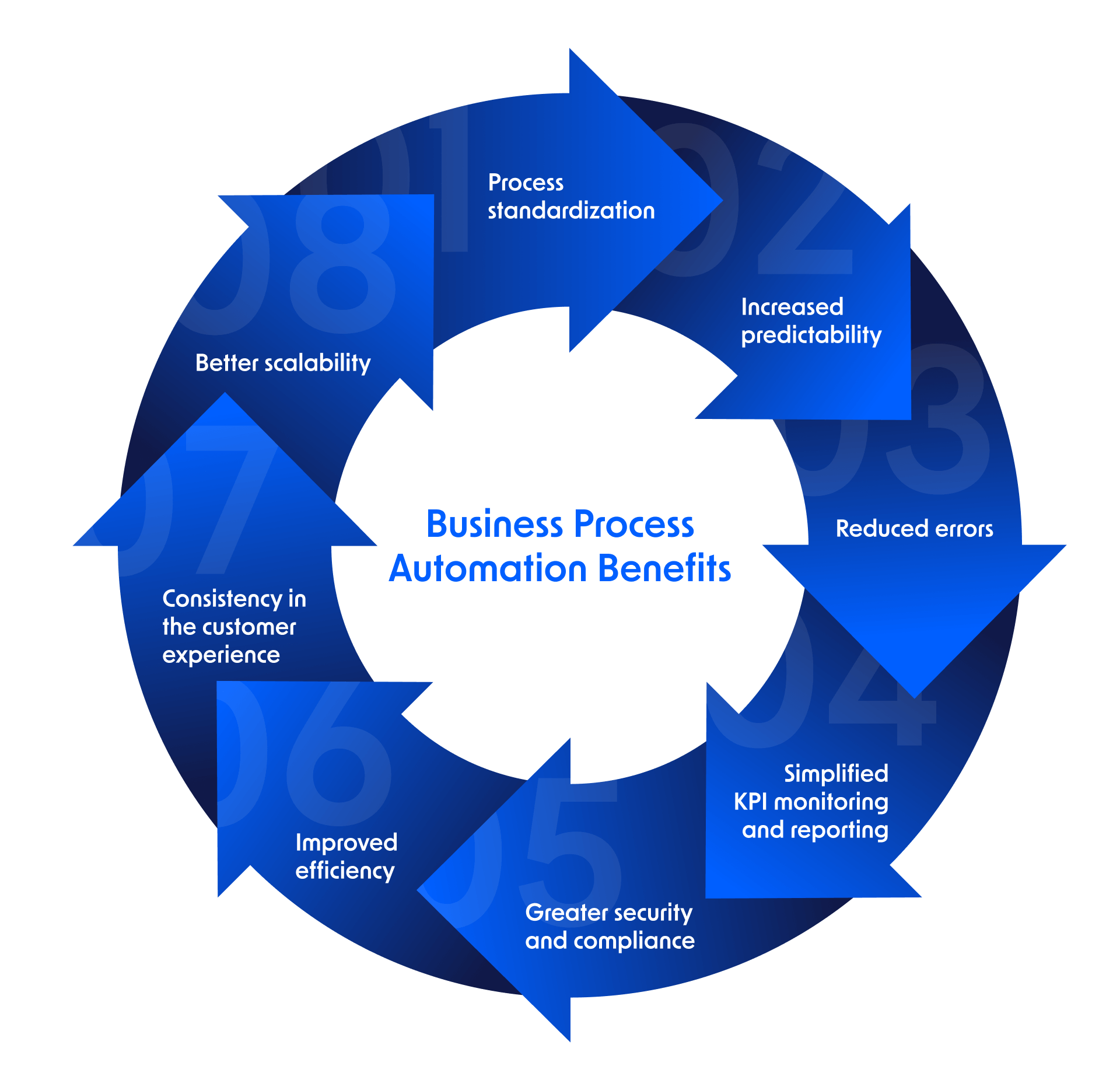
Business Process Automation benefits beyond efficiency and speed
When people hear the phrase “business process automation (BPA),” there’s a tendency to focus on that last part: automation. As companies lean into digital transformation initiatives, they look for new opportunities — and tools — to automate a process.
This is hardly a surprise. After all, process automation plays a key role in the shift towards digitalization and acts as a gatekeeper for those ready to embrace digital operations. Business process automation eliminates repetitive tasks, speeds up workflows, and improves productivity. Automation helps companies make the transition from manual to digital.
The Definitive Guide to Business Process Automation

But automation is only part of the story. The fact is that business process automation tools do far more than just make workflows more efficient. Below, we consider five of the most important (and overlooked) reasons why businesses benefit from the use of business process automation.
| 65% | of businesses reported pursuing automation as a catalyst to modernize legacy business practices. |
| 57% | of businesses reported that enabling a truly digital workforce (with end-to-end automation) was an operational strategy in 2021. |
Source: “Pandemic Operational Strategies: Automate Legacy, Digitize Workers, Modernize and Outsource.” HFS Research.
5 top benefits of Business Process Automation

1. Increases agility
One of the main benefits of Business Process Automation tools is to digitalize manual processes, a transformation that increases business team agility. Digital processes (and workflows) can be built and adapted faster than their manual counterparts. As a result, business teams can respond more quickly to customer feedback, competitor activity, and changes in the market. Low-code BPA solutions allow permissioned users to model, implement, or modify processes with just a few clicks.
BPA tools also provide real-time data in dashboards and reports, a feature that makes it possible to quickly assess the impact of any changes to the process, or to identify bottlenecks or other issues that may arise. As soon as teams are aware of a problem (or identify a new opportunity), they are able to design and implement a workflow solution, all without having to know any code.
In other words, low-code automation allows business units to optimize their processes without always having to wait for the IT team. Since security and compliance features are built into the BPA tool, the optimization avoids the backlog and doesn’t create additional work for IT.
2. Reduces risk
Another often overlooked benefit of Business Process Automation is its capacity to mitigate risk. BPA tools work by bringing control, structure, and predictability to processes and workflows. As a result, risks are more easily detected and resolved. This risk reduction benefit is an important one, and it can be considered from three perspectives: enforcement, visibility, and error reduction.
BPA makes it easier to enforce security and compliance requirements
Many businesses have to contend with different departments and/or geolocations that develop their own unique processes and workflows. As a result, they have to try and enforce requirements on many variations of the same process. If five teams are doing things five different ways, then there are five different processes to monitor and maintain for security and compliance.
BPA solves this problem by standardizing processes throughout the organization and bringing consistency to workflows, regardless of where they take place. BPA creates consistent, structured processes which make it easier for companies to enforce security, compliance, and governance requirements.
BPA provides deeper visibility into processes
Other Business Process Automation benefit is that makes it easier to monitor performance, track KPIs, and identify potential problems in the process flow because of the access to real-time data. As a result, businesses can take a proactive stance toward process optimization and risk management.
Permissioned users can access dashboards and reports that reveal the impact of a range of factors on a particular process or workflow. For example, users can see if a recent change is creating a bottleneck or increasing the time it takes to process an approval. The sooner a problem is recognized, the sooner it can be addressed.
BPA improves accuracy
A third way BPA reduces risk is that automation eliminates many of the errors that occur when work is completed manually. For example, manual data entry is notoriously prone to mistakes, and every point in the workflow where information is transferred from one system, app, or tool to another is an opportunity for a mistake or miscalculation. These errors can be costly both in terms of the damage they cause, as well as the amount of time and effort it takes to correct them.
For companies with complex tech stacks, the integration capabilities of a BPA tool can further minimize opportunities for error. By connecting data sources, standardizing forms, and creating seamless user paths, Business Process Automation benefits the team’s control of how data is managed in order to maintain its integrity.
The Buyer’s Guide to Automation Platforms

3. Amplifies ability to scale
Sooner or later, every growing business must find a way to scale its processes. Most of the time, they have to do so with existing resources. Low-code BPA addresses the issue of scalability by giving business teams the tools they need to increase their capacity and develop new workflows quickly.
We already know that low-code BPA helps businesses scale by reducing the amount of time it takes to complete a process. Many tasks are automated, there are fewer errors to correct, and workflows speed up. The less time it takes to complete the work, the more work can be completed.
But BPA’s ability to help businesses scale goes beyond increased efficiency. BPA reduces the dependency on paperwork and spreadsheets, two techniques that are notoriously resistant to efforts to scale. BPA also allows teams to use conditional logic and rules to sort and route items in the workflow. This feature eliminates bottlenecks and reduces delays, both of which limit scalability because they reduce capacity.
Most importantly, low-code BPA gives process owners and managers the tools to build and adapt processes quickly. When a new workflow is needed to accommodate a new type of request or work item, the business team can snap it together much faster than if they have to submit a ticket to IT.
4. Improves customer experiences
In a 2021 global customer experience survey by NTT, 93% of CEOs described customer experience (CX) as either a primary (53%) or secondary (40%) differentiating factor for businesses. These findings confirm what most business leaders (and consumers) know from experience: CX matters. It matters because the quality of the experience impacts the brand’s reputation, degree of customer loyalty, and how much customers are willing to pay for products and services.
Despite the prominent role CX plays in business success, improving customer experiences isn’t always easy. A deeper look at the survey’s data revealed some of the primary challenges businesses face when “optimizing customer journeys for CX”:
| Percentage reporting | Challenge |
|---|---|
| 39.9% | Silo management (lack of interdepartmental collaboration) |
| 37.4% | Organizational policies (lack of clear escalation paths) |
| 35.5% | Lack of automation |
| 33.5% | Lack of data (inability to get insight from trusted data) |
| 29.6% | Integration of systems across multiple channels |
Source: “2021 Global Customer Experience Benchmarking Report“. CX: Customer Journey, Question 21, United States. NTT.
BPA software can be leveraged to overcome each of these obstacles. For example, BPA tools can:
- Dissolve data silos and improve cross-team collaboration.
- Build and visualize workflows that define escalation paths and conform to policies.
- Allow users to create automations using a drag-and-drop interface.
- Convert information to actionable insights through dashboards and reports.
- Integrate with legacy tech stacks to create seamless customer experiences.
5. Drives better business decisions
BPA empowers leaders and managers to make confident, data-driven decisions. Self-service data takes leaders out of the dark by allowing them to monitor process health, track KPIs, and determine the quality of their process outcomes. Reporting and dashboard features are easily customized with drag-and-drop menus, so leaders won’t have to wait for the data they need.
Integrating BPA with existing apps and platforms expands these capabilities and consolidates data into a single, visually-engaging dashboard. BPA tools convert this information into actionable insights, a feature that can help leaders and managers make sense of complexity, respond quickly when needed, and assess the impact of competitor activity, customer behavior, and workflow modifications in real-time and with certainty.
Get more than automation from your BPA
Low-code Business Process Automation delivers more benefits than automation. Low-code integrates with existing tech stacks to break down data silos, improve user experiences, and create simplicity out of complexity. And with low-code’s drag-and-drop interface, process owners can model and modify processes without adding to the IT backlog.






